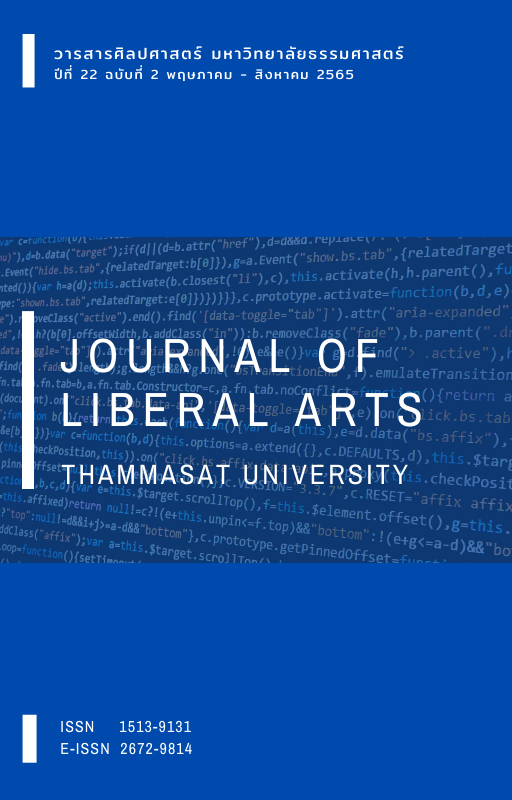Attributes of Young Innovators
Main Article Content
Abstract
This article aims to present the attributes of innovators . The purpose is to reveal and synthesize the attributes of young innovators through the study and review of documents and related research, then use the obtained indicators to create an opinion questionnaire using the opinions of seven experts in order to provide information for clarifying and synthesizing the indicators of the attributes of young innovators. The data collection tool is a questionnaire based on expert opinions about compliance verification and suitability of the attributes of young innovators of students, and after analyzing the consistency index value, an average of suitability and feasibility, the result shows that there are seven indicators of the attributes of young innovators of students as follows. Young innovators are able to: 1) play creatively, 2) be motivated, 3) be observant and be able to see problems, 4) seek knowledge through asking questions, finding answers, and experimenting in order to acquire new knowledge, 5) demonstrate creativity, 6) show commitment and continuous work, and 7) be able to work with others. These indicators are consistent and appropriate. The Index of Item – Objective Congruence (IOC) have 0.83 of total average value and 0.36 of standard deviation. The suitability issues have 3.86 of total average value and 1.44 of standard deviation at a high level. The result of the seven indicators of Attributes of Young Innovators will take part in an education management program designation in order to develop young innovators’ attributes for students in the future.
Downloads
Article Details

This work is licensed under a Creative Commons Attribution-NonCommercial-NoDerivatives 4.0 International License.
References
กระทรวงศึกษาธิการ. (2561). หลักสูตรแกนกลางการศึกษาขั้นพื้นฐาน พุทธศักราช 2560. โรงพิมพ์องค์การรับส่งสินค้าและพัสดุภัณฑ์.
กิตติศักดิ์ อังคะนาวิน. (2560). การศึกษาไทย 4.0 ในบริบทการจัดการศึกษาเพื่อการพัฒนา ที่ยั่งยืน. วารสารบริหารการศึกษา มศว, 14(26), 149-151. http://ejournals.swu.ac.th/index.php/EAJ/article/view/9279/7977
แดนไท สุขกำเนิด. (2562, มีนาคม). “Creating Innovators”: สร้างคนรุ่นใหม่ให้เป็นนวัตกรเปลี่ยนโลก. [Video]. YouTube. https://www.youtube.com/watch?v=8QDC9GC3S7Y&t=8s
ธิปกร นกุลวรภาส, และ ศรินทร์ วัชรบุศราคำ. (2562, มีนาคม). นวัตกรรุ่นใหม่ ที่ผู้ใหญ่รอบตัวเด็กทุกคนสามารถสร้างได้ Creating Young Innovators. [Video]. YouTube. https://www.youtube.com/watch?v=q3Y0dJ1WGKw
พัทน์ ภัทรนุธาพร. (2562, มีนาคม). “Creating Innovators”: สร้างคนรุ่นใหม่ให้เป็นนวัตกรเปลี่ยนโลก. [Video]. YouTube. https://www.youtube.com/watch?v=8QDC9GC3S7Y&t=8s
พัชรพร อยู่ยืน. (2561). ปัจจัยที่มีอิทธิพลต่อการเป็นนวัตกร: กรณีศึกษาผลิตภัณฑ์ PUNN (การศึกษาค้นคว้าอิสระปริญญามหาบัณฑิต). มหาวิทยาลัยศิลปากร.
มหาวิทยาลัยเทคโนโลยีพระจอมเกล้าธนบุรี. (2560). คู่มือการจัดการเรียนการสอนโครงการพัฒนาแนวทางการจัดการเรียนการสอนและกิจกรรมเสริมหลักสูตรด้านความเป็นผู้ประกอบการ รายวิชา กระบวนการคิดเชิงออกแบบ (Design Thinking). มหาวิทยาลัยเทคโนโลยีพระจอมเกล้าธนบุรี.
เมษ์ ศรีพัฒนาสกุล. (2562, มีนาคม). “Creating Innovators”: สร้างคนรุ่นใหม่ให้เป็นนวัตกรเปลี่ยนโลก. [Video]. YouTube. https://www.youtube.com/watch?v=8QDC9GC3S7Y&t=8s
วีระศักดิ์ สุระเรืองชัย. (2562, มีนาคม). “Creating Innovators”: สร้างคนรุ่นใหม่ให้เป็นนวัตกรเปลี่ยนโลก. [Video]. YouTube. https://www.youtube.com/watch?v=8QDC9GC3S7Y&t=8s
วสันต์ สุทธาวาศ, และ ธีระวัฒน์ จันทึก. (2559). วิธีพัฒนาศักยภาพความเป็นนวัตกรการศึกษา. Veridian E-Journal, Silpakorn University ฉบับภาษาไทย สาขามนุษยศาสตร์ สังคมศาสตร์ และศิลปะ, 9(1), 748-767.
สถาบันส่งเสริมการสอนวิทยาศาสตร์และเทคโนโลยี. (2557). STEM EDUCATION. โรงพิมพ์คุรุสภาลาดพร้าว.
สงคราม เชาว์นศิลป์. (2537). พัฒนาการของพฤติกรรมมนุษย์. ภาควิชาจิตวิทยา คณะมนุษยศาสตร์ มหาวิทยาลัยเชียงใหม่.
สมเกียรติ ตั้งกิจวานิชย์. (2562, มีนาคม). “Creating Innovators”: สร้างคนรุ่นใหม่ให้เป็นนวัตกรเปลี่ยนโลก. [Video]. YouTube. https://www.youtube.com/watch?v=8QDC9GC3S7Y&t=8s
สำนักงานปลัดกระทรวงศึกษาธิการ. (2561). แนวทางสร้างนักนวัตกร และโรงเรียนเตรียมนวัตกร วิธีพัฒนาศักยภาพความเป็นนวัตกรการศึกษา. http://www.moe.go.th/moe/upload/news
สำนักงานนวัตกรรมแห่งชาติ. (2555). นวัตกรรม. http://www.nia.or.th
Dyer, J., Gregersen, H. B., & Christensen, C. M. (2011). The innovator’ s DNA: Mastering the five skills of disruptive innovators. Harvard Business.
Newquist, E. (2015). 7 Characteristics of Highly Successful Innovators – Innovation. https://www.disruptorleague.com/blog/2015/03/13/7-characteristics-of-highly-successful-innovators/
Perignat, E. (2018). STEAM in Practice and Research: An Integrative Literature Review. https://doi.org/10.1016/j.tsc.2018.10.002
Premuzic, T. C. (2013). The Five Characteristics of Successful Innovators. Retrieved Sep, 30, 2018, from https://hbr.org on
Wagner, T. (2018). Creating Innovator. Harvard University.
Yakman, G. (2012). Exploring the Exemplary STEAM Education in the U.S. as a Practical Educational Framework for Korea. https://doi.org/10.14697/jkase.2012.32.6.1072

